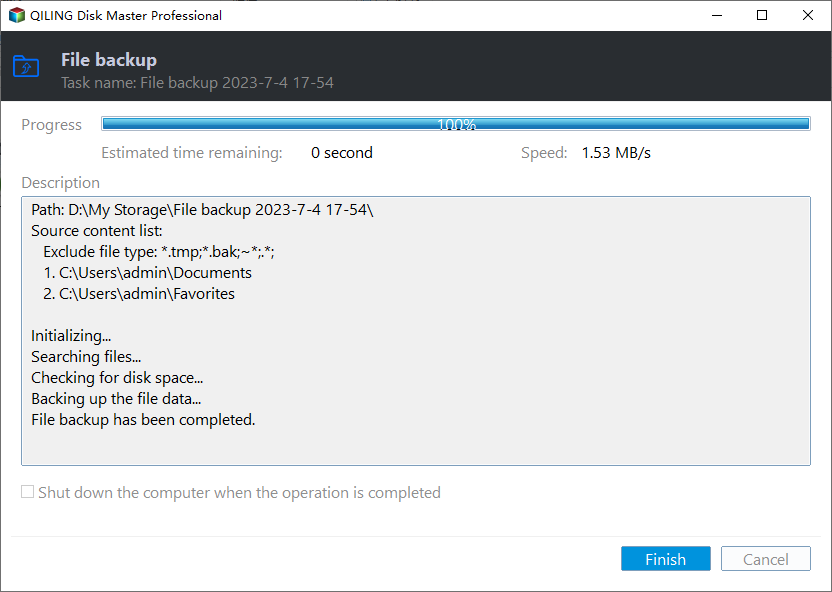How to backup email with Qiling Disk Master
Quick Navigation:
- Create Email Backup in Windows 10 Step-by-Step
- Prerequisites for Email Backup
- Detailed steps about how to back up Email
- Conclusion
Regular email server backups are a crucial measure that ensures the security, integrity, and reliability of email data, preventing data loss and facilitating easy recovery, ultimately promoting work efficiency and data security.
Qiling Disk Master offers an Email Backup feature that allows easy backing up of emails from Email Server, supporting various mailboxes including Gmail, Outlook, Yahoo, and more.
Create Email Backup in Windows 10 Step-by-Step
Prerequisites for Email Backup
To get started, download and install Qiling Disk Master on a Windows computer, and make sure the computer has a stable network connection.
A designated area with sufficient space to store backup files, which can be a local directory or a shared network storage device.
To access email backup, you need to upgrade to a paid version of the software, such as Qiling Disk Master Professional or other editions, depending on your specific use environment.
Detailed steps about how to back up Email
Qiling Disk Master supports backup for multiple mailbox types, including Gmail, which we will use as an example to demonstrate the detailed steps involved.
1. In the left tab page, select "Backup" followed by "File Backup".
2. To make it easier to distinguish this task from other backups, you can name the task on the "Task Name" box.
3. To add Gmail or other email accounts, click "Add Email Data" and follow the steps to add Gmail, or refer to the instructions for other mailboxes, which can be found in the article "How to add mailbox for email backup in Qiling Disk Master".
After adding the mailbox, it lists all directories of your mailbox, including Inbox, Starred, Sent Mail, Trash, and more. The structure is the same as your official mailbox. Select the whole mailbox or specific directories to back up, then click "OK".
Tips: If you add multiple mailboxes, you can also select multiple mailboxes at the same time.
4. To store the backup image file, select or type the destination path where you want the backup to be saved. This could be a specific folder or location on your computer or external drive.
The additional features include the ability to customize the interface, schedule reminders, and integrate with popular productivity tools, making it easier to stay organized and focused.
Options: Here are the various settings to enhance functionality and customization in one paragraph:
- Choose a compression level to balance storage space usage with backup integrity.
- To enhance the security of your backup, consider enabling encryption. This feature safeguards your backup from unauthorized access, providing an additional layer of protection against potential threats.
- Splitting Image: A tool that divides large backup files into smaller segments, making them easier to store and compatible with various storage devices.
- Receive email notifications to stay informed about the status and completion of backup tasks, ensuring peace of mind and proactive monitoring.
Schedule Backup: Scheduled backups can be set up to automatically back up the system at specified intervals, such as daily, weekly, or monthly, to account for the constant changes in systems and data. Additionally, in the paid version, event triggers can be utilized or backups can be initiated upon a USB plug-in, providing more flexibility and control.
With backup schemes, you have the option to choose between incremental and differential backup methods, allowing for efficient backup storage management. Incremental backup captures only changes since the last backup, while differential backup captures changes since the last full backup. The paid edition can also automatically delete older backup images to free up disk space.
5. Select the "Proceed" button to begin the backup process.
6. And, click "Finish" once the process has been completed.
Notes:
- When the backup process starts, you can click the icon in the lower left corner to check backup integrity and/or Shut down/Restart/Hibernate/Sleep PC after the backup is completed.
- Backup operations cannot be performed when the system is not logged in. So, please confirm the system is logged in before scheduling a backup.
Conclusion
To ensure your email data is fully backed up and protected, take these simple and reliable steps. This includes backing up your email to prevent accidental deletion, hardware failure, or other unexpected situations. By doing so, you can confidently restore and access important communication records. We recommend regularly performing email backups to safeguard your valuable information and ensure it's never lost. For detailed restoration steps, please refer to the Email Restore section.
Related Articles
- Create System State Backup for Windows 10 [2 Free Ways]
This article introduces you how to create system state backup in Windows 10 with native Windows 10 backup software and third-party tool. - Auto Backup Windows 10 to WD My Cloud | 2 Easy Ways
This tutorial presents how to run WD My Cloud auto backup on Windows 10 in two efficient ways. You may use File History to backup files or Qiling Disk Master to backup the whole PC. - Error: Windows 10 Inaccessible Boot Device After Clone [Solved]
This article provides 5 solutions for the error of Windows 10 Inaccessible Boot Device after clone. It also introduces a better intelligent cloning software. - How to Wipe C Drive Securely in Windows 10 | 3 Methods
Learn how to wipe C drive in Windows 10 for different purposes, like hard drive replacement or clean reinstallation. For higher flexibility and security, you can try Method 3.



